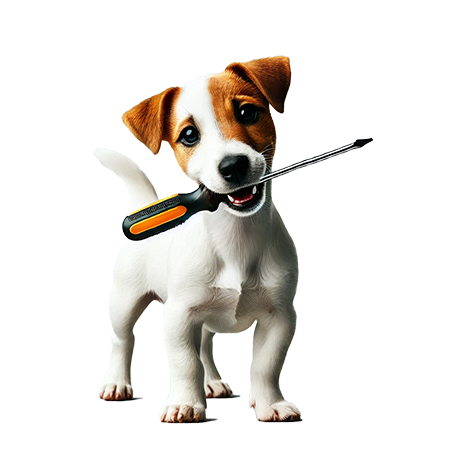
Customer Assistance for help with assembly.
If you are having any difficulties with the assembly please get in touch via email at info@designerdoghomes.co.uk or via our contact form by clicking here. If you leave a contact number we will give you a ring to talk you through any problems.
Customer Assistance for Damaged or Missing Parts
We strive to ensure that every product reaches you in perfect condition and with all necessary components included. However, if you find that a part is damaged, missing, or if any fixings are not included, please don’t hesitate to get in touch with us.
1. Email: Send us a detailed email at info@designerdoghomes.co.uk. Please include: Your order number. A description of the issue (e.g., damaged or missing part). Photos of the damaged part (if applicable) to help us resolve the issue quickly.
2. Contact Form: Alternatively, you can use our contact form by clicking here.
Next Steps: Once we receive your message, our customer service team will respond promptly to resolve the issue. We can arrange for a replacement part or fixings to be sent to you as quickly as possible.
Thank you for choosing Designer Dog Homes! We’re here to make your experience smooth and hassle-free.

Aftercare Advice
Painting an Indoor Dog Kennel
Choosing the Right Paint
1. Non-Toxic Paint: Use pet-safe, non-toxic paint. Look for water-based paints labeled as "low-VOC" or "zero-VOC" to minimize harmful fumes.
2. Durable Paint: Choose a durable paint that can withstand wear and tear, such as an acrylic-based paint or interior latex paint.
3. Moisture-Resistant Paint: For kennels exposed to water spills or cleaning, use a paint designed for high-moisture areas, such as semi-gloss or satin finish.
Preparation Before Painting
1. Surface Cleaning: Clean the surface thoroughly with a damp cloth to remove any dust.
2. Priming: Apply a primer suitable for MDF or plywood, such as a water-based wood primer. Priming seals the surface and prevents paint absorption. For MDF, you can use a specialized MDF primer to ensure even coverage.
Painting Tips
1. Ventilation: Paint in a well-ventilated area to ensure the paint dries properly and fumes dissipate.
2. Thin Coats: Apply paint in thin, even coats using a brush or roller. Allow each coat to dry completely before applying the next (refer to the paint can for drying times).
3. Sealing the Paint: Once painted, apply a clear, non-toxic sealant (e.g., a water-based polyurethane) to protect the surface and enhance durability.
4. Curing Time: Allow the paint and sealant to cure completely (this can take up to a week) before allowing your dog to use the kennel.
Other Treatments for MDF or Plywood
1. Wood Stain
Purpose: Enhances the natural look of plywood while adding some protection.
Tips: Use a water-based stain for safety. Follow with a water-based polyurethane to seal and protect the stained surface.
2. Varnish
Purpose: Provides a glossy, durable finish that protects against scratches and moisture.
Tips: Use a non-toxic, water-based varnish for pet safety. Apply in thin layers and sand lightly between coats for a smooth finish.
3. Linseed Oil or Danish Oil
Purpose: Penetrates the wood, providing a natural, non-toxic finish.
Tips: These oils are safe when fully cured but may take longer to dry. Avoid raw linseed oil; instead, use boiled linseed oil for quicker curing.
4. Laminate or Veneer
Purpose: Adds a durable, decorative layer to plywood or MDF without painting.
Tips: Ensure proper adhesion to avoid peeling. Laminates can provide a smooth, easy-to-clean surface.
5. Protective Wax
Purpose: Provides a natural, matte finish while adding water resistance.
Tips: Use pet-safe furniture wax, and buff it to a smooth finish.
Things to Be Careful Of
1. Toxicity: Always verify that the paints, sealants, or treatments are pet-safe once cured.
2. Chewing: If your dog is prone to chewing, avoid paints or treatments that chip easily. Use a high-durability paint and a strong sealant.
3. Odour: Allow adequate drying and curing time to ensure any residual odour or fumes are gone before letting your dog use the kennel.
Additional Tips
1. Colour Choice: Opt for lighter colours to make the kennel feel airy and inviting, but avoid white if it might show dirt easily.
2. Maintenance: Wipe the painted surface regularly with a damp cloth to keep it clean, and avoid harsh chemicals that could damage the finish.
By following these steps, you’ll ensure the kennel is safe, durable, and appealing for both you and your furry friend!
Disclaimer
The advice provided above is intended as general guidance for painting or treating indoor dog kennels and is based on best practices. Designer Dog Homes Limited cannot be held responsible for any issues, damages, or injuries that may arise from the use of paints, treatments, or techniques recommended in this guidance.
Customers should verify the suitability and safety of all materials, products, and methods for their specific circumstances and comply with all applicable UK laws and regulations, including product safety standards. Always follow manufacturer instructions for any paints or treatments used and ensure the wellbeing of pets at all times.
If you are unsure about any aspect of the advice provided, we recommend seeking professional advice or consulting with the product manufacturer directly.
